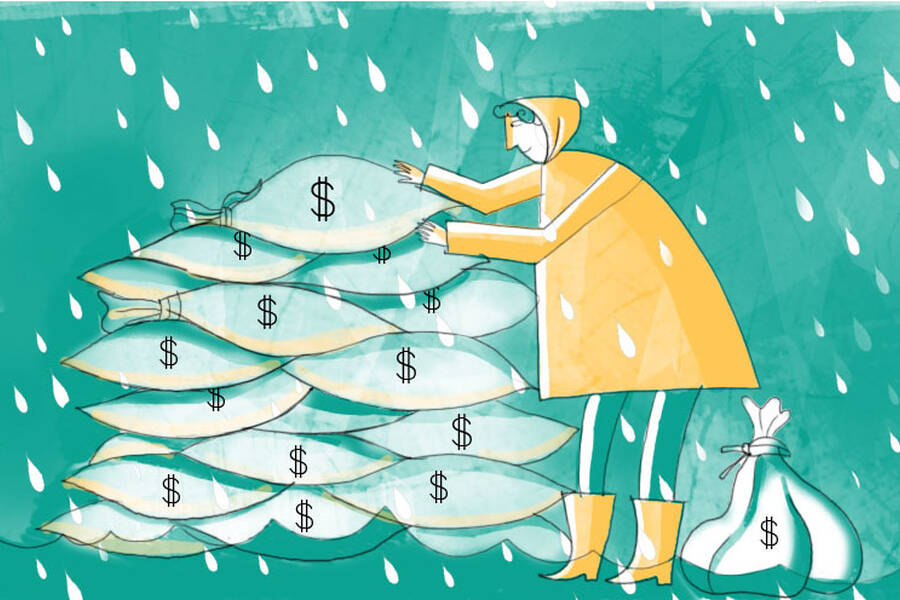Economics Nov 1, 2019
How Dodd-Frank Made Commercial Mortgage Loans Safer
The financial reform bill increased the cost of certain loans, but lowered the risk of default.

Yevgenia Nayberg
The Dodd-Frank Act was enacted in the aftermath of the Great Recession in hopes of reigning in some of the financial industry’s riskiest practices. So how well did it work?
Kellogg’s Craig Furfine was specifically interested in the effectiveness of one particular requirement: that those who sell mortgage-backed securities to investors retain five percent of the risk of those securities themselves.
In the lead-up to the financial crisis, Furfine explains, “institutions would make loans and then sell those loans to somebody else, who would then sell securities backed by those loans to investors. Because the institution making the loan didn’t end up bearing its risk, the belief was that they didn’t have the incentive to make sure that the loans were actually good loans.”
This particular part of Dodd-Frank, implemented in late 2016, mandated that the institution selling securities backed by these loans maintain five percent of the overall risk, so that it bears some consequence if the loan turns out to be of low quality.
Furfine, a clinical professor of finance, found that commercial mortgage loans subject to Dodd-Frank were indeed of higher quality than those exempt from the legislation. But borrowers end up paying higher interest for the loans. Furfine says this may be a fair trade-off because higher-quality loans help to lower the odds of another financial downturn.
Making Securitization More Secure
Furfine’s research focuses on the process of securitizing commercial mortgage loans, or those provided for finance projects such as shopping centers or apartment buildings. A securitizer buys a number of mortgage loans and pools them to sell to investors as a security.
This means, Furfine explains, that “the ultimate owners of that mortgage-backed security will be a set of bond investors, rather than a particular financial institution.”
A securitizer might be a bank that originated some of the pooled loans in the first place, or an institution that did not originate any of the loans itself but acquired them from others to pool and sell to investors.
Dodd-Frank stipulates that the securitizer cannot pass on all of the risk of the mortgage loans to investors: they have to maintain at least five percent of the risk.
“The idea is that since the securitizer has to hold some risk, they’ll make sure the loans they buy are of higher quality,” Furfine says. “And if the institutions that originate the loans know the securitizer will insist on high quality, they’ll originate higher-quality loans.”
In this way, Dodd-Frank was meant to have an impact on the entire chain of financial-services players associated with mortgage-backed securities, including the original lenders. This would mean that commercial mortgage loans would be less risky—less likely for borrowers to default on—and thus less likely to contribute to another downturn or recession.
Would implementation of the regulation improve the nature of these loans, as hoped?
A Key Comparison
Dodd-Frank exempted from risk-retention requirements all mortgages guaranteed by government-sponsored agencies, like Freddie Mac and Fannie Mae. Because virtually all residential mortgages carried such guarantees at the time of Dodd-Frank’s implementation, Furfine studied securitized commercial mortgages rather than residential ones. A large percentage of commercial-mortgage securities, in contrast, were subject to Dodd Frank, which made it feasible to compare those affected to those that were not.
To understand the impact of Dodd-Frank, the research compared how commercial real-estate loans that went into securities changed before and after the legislation went into effect. And it compared those changes to any change in similar loans exempt from Dodd-Frank over that same period, to ensure observed changes were due to the regulation itself rather than external factors.
“Policymakers may look at these results and say, ‘We like the trade-off,’ because they perceive that the benefits outweigh the costs.”
If the regulation worked as hoped, commercial real-estate loans subject to Dodd-Frank would improve in quality post-Dodd-Frank, compared to those exempt from the risk-related regulation.
The research data included 1,145 commercial-mortgage-backed securities deals completed between early 2014 and early 2018, which represented over 62,000 mortgage loans. Furfine measured two variables related to the riskiness of these loans: the amount borrowed compared to the estimated value of the property, which is called the loan-to-value ratio (LTV); and the debt-service-coverage ratio, which is how much cashflow the property is expected to generate (such as through tenants’ rent payments) versus the mortgage payment due to the lender each month. A higher LTV is associated with greater risk, as is a lower debt-service-coverage ratio.
Greater Skin in the Game, Lower Risk
The results showed that implementation of Dodd-Frank resulted in less risky commercial mortgage loans overall.
“Loans subject to the risk-retention rules had LTV ratios that were 3.6 percentage points lower and debt-service-coverage ratios 0.26 higher than loans exempt from the rules,” Furfine says. “That’s consistent with the policymakers’ objective of reducing risk.”
Beyond these overt measures of risk, the post-Dodd-Frank loans were also safer in subtler, harder-to-measure ways. For example, a factor that contributed to the financial crisis was that some mortgage-backed securities included loans that seemed safer on paper than they actually were.
Furfine provides an example: “The original lender might know that a loan’s debt-service-coverage ratio looks good now but will actually drop because a major tenant will be exiting the property. Such information may have been difficult to communicate clearly to bond investors.”
To get at this less observable dimension of quality, Furfine ran a broad analysis on loan performance over time to see if commercial mortgage loans were “performing” as hoped—that is, being paid back on time. Here again, loans that were subject to risk retention were more likely to be performing better than those exempt from the Dodd-Frank rules.
But there’s a catch: mortgage loans affected by Dodd-Frank, while less risky, were also more expensive, requiring borrowers to pay 47 basis points, or 0.47 percentage points, more in interest than for unaffected loans.
“That’s counterintuitive,” Furfine says. “If a loan is safer for the lender, then you should be able to get it at a lower interest rate, based on economics. But what’s happening is that it’s getting more expensive for the lender to make that loan, and that makes it more expensive for the borrower.”
This expense is because lenders in the post-Dodd-Frank era may face greater explicit costs, such as having to hire more attorneys and consultants to make sure they’re in compliance with the increased regulations. They may also face the higher implicit costs of being required to retain at least some of the risk related to mortgage-backed securities.
“It used to be that they could just sell all the loans,” Furfine says. “But now they have less flexibility and they see that as a cost.” The research suggests that at least some of this cost gets passed along to borrowers.
A Fair Trade-off
While borrowers appear to have gotten the short end of the lending stick here, it may be for the greater good.
“It’s true that borrowers get less friendly loan terms,” Furfine says. “But this may be preferable because we’ve reduced the probability of some future financial crisis that could hurt everyone in the system.”
“Regulation is costly,” Furfine adds. “So the important question is: What are the benefits? Here, the benefit is that loans are safer. Policymakers may look at these results and say, ‘We like the trade-off,’ because they perceive that the benefits outweigh the costs.”





